Quality of the Environment in Japan 1990
(9) Enactment of Law for Controls on Domestic Transaction of Endangered Wild Fauna and Flora
In order to contribute to an effective implementation of CITES, the Law for Regulations on Domestic Transaction of Endangered Wild Fauna and Flora (officially called the Law for the Regulation, etc., of the Transfer of Endangered Species of Wild Fauna and Flora) was enacted in December 1987, but in conjunction with the revision of Appendices to CITES at its Seventh Meeting of the Conference of the Parties, the administrative ordinance was amended to make the law compatible with the revision and make necessary additions and dele-tions in regard to Endangered Wild Fauna and Flora the domestic transfer of which was subject to controls. As a result, the number of species in Endangered Fauna and Flora became 749 as a whole, includ-ing 520 species and subspecies of fauna and 229 species of flora.
After about two years of enforcement of the law, the statistics show that by October 31, 1989, permission was granted for the transfer, etc. of 114 individuals, and 5,994 individuals were registered, making possible their transfer, etc.
(10) Enhancement of Public Awareness Towards Protection of Wild Birds and Mammals
In order to enhance public awareness towards the policy for protection of wild birds and mammals, the Meeting for the Protection of Birds Across the Nation in the 43rd Bird Week was held in Saitama Prefecture as one of the events during the National Bird's Week. The National Convention for the Presentation of Actual Records on the Protection of Birds, where reports were presented on practical activities on the protection of wild birds and mammals primarily by model schools for the loving of birds, and other events were held.
IV .Conservation of Natural Environment in Forests
For the conservation of forests, efforts are being made to work for the promotion of appropriate forestry management under a forest planning system, for the maintenance and cultivation of forestry resources and for the display of multilateral functions equipped to forests by appropriately enforcing the system of authorization for the development of forest land, properly carrying out the forest protection system and stepping up measures for the extermination of forest blight and the like.
1. Forest Programs
In order to display in a comprehensive and sophisticated manner the multiphasic functions equipped to forests, such as lumber produc-tion, conservation of land, and water resources, and conservation and formation of the natural environment, efforts are being made to work for an appropriate enforcement of the forest planning system.
For an encouragement of the forest development, such as thinning and nursing, efforts were made for an appropriate execution of forest development programs by municipalities, and the modification, etc. of forest programs for related areas was conducted to determine measures which would have to be promptly enforced for forests in the areas of specified protection forests.
2. Protection Forests
The designated area of protection forests measured about 8,680, 000 hectares as of the end of fiscal 1988, and in order to let forests display their public-good functions to a higher degree, such as the conservation of land and water resources, conservation and formation of the natural environment and the offer of places for rest and creation, the designation of systematic protection forests and that of specified protection forests to maintain the functions of less functional forests were made under protection forest development programs, and efforts were made for the appropriate maintenance and management of protec-tion forests.
3. Conservation and Management of Protection Forests
In order to contribute to the maintenance of multiphasic func-tions equipped to forests, the extermination of forest blight was con-ducted and necessary grants-in-aid were offered under the Law for the Extermination of Forest Blight, Etc. Particularly in regard to measures against forest blight, etc., measures for prevention and extermination, including the aerial spraying of chemicals and the destruction and incineration of afflicted trees, and the alteration of tree species were urgently and comprehensively conducted, while giving consideration to conservation of the environment, under the Law Concerning Special Measures Against Pine Weevils. At the same time, the subsidization of damage control measures by the owners of pine trees and the like, the early nursing and supply of resistive pine trees were done.
For promotion of the forest development with the people's involvement, the establishment and development of a national-level Fund for Forests With Water and Green, to which contributions would be made by the people, businesses and so forth on a voluntary and independent basis, were stepped up. The system of BUNSHURIN was positively promoted, and the building of models for the forest develop-ment in response to the people's diversified needs was promoted with forestry associations using the trust and other systems.
In national forests, furthermore, protection forests were reorgan-ized and expanded, such as by stepping up the designation of areas for the protection of forest ecosystems, which would contribute to the maintenance of the natural environment, which is made up of forest ecosystems, by conserving primitive natural forests.
V .Nature Conservation in Urban Areas and Cultural and Historic Environment
1. Nature Conservation in Urban Areas
The natural environment, such as forest land and grassland, play a significant role in the purification of air easing of climatic conditions, prevention of disorderly urban development and prevention of environ-mental pollution and disasters. It also constitutes a factor indispensable for the building of a comfortable urban environment, including the supply of space for recreation and the formation of beautiful streets. For the protection and cultivation or restoration of the natural environ-ment, the following measures were implemented in fiscal 1988.
(1) People's Parks and National Cemetery
The Outer Garden of the Imperial Palace, which was a garden for the Imperial Family, the Shinjuku Imperial Garden and the Kyoto Imperial Garden have been placed under the custody of the Environment Agency and broadly used with affection since fiscal 1971.
The Outer Garden of the Imperial Palace (including the Kita-no-Maru area) measures 114.9 hectares, used by about 8 million people a year. The Kita-no-Maru area is developed as a forest park and the plaza in front of the Imperial Palace is developed primarily with pine trees and lawns.
The Shinjuku Imperial Garden is a garden in a blending of Japanese and Western styles typical in the Meiji Era with an area of 58. 3 hectares. In addition to 1,900 cherry blossom trees in about 50 species, flowering trees are so arranged that people may enjoy flowers through-out the year. The garden is visited by one million people a year.
The Kyoto Imperial Garden surrounds the Kyoto Imperial Palace with an area 65.3 hectares, playing the role of a central park for Kyoto City, too. The garden is visited by about 6 million people a year.
In the Shinjuku Imperial Garden and the Kyoto Imperial Garden, woods for mothers and children are developed to enable them to have greater chances to hold communion with nature. They are used for meetings to observe nature and other purposes.
The National Cemetery is a garden with an area of little more than 1.6 hectares, enshrining the ashes of 331,757 servicemen (as of March 1990) which have been recovered abroad in the postwar years but cannot be returned to the bereaved families. The cemetery is visited by about 150,000 people a year.
(2) Formulation of Green Zone Master Plan
In order to prevent deterioration of the environment caused by urbanization and form a more comfortable urban environment, the formulation of Green Zone Master Plan for each city planning area designed for the development and conservation of green zones and open space in cities was promoted.
(3) City Parks
City parks are open spaces which are indispensable for mitigating environmental pollution, functioning as places for refuge at disasters and responding to increasing and diversified requirements, such as in sports and culture. They are basic public facilities.
As regards city parks, 5-year plans for the development of city parks have been formulated to promote their systematic development under the Law Concerning Emergency Measures for the Improvement of City Parks. A check of the development of city parks indicates that the area of city parks per person stood at 5.2 m2, or about one-fourth of the 20 m2 or so, the standard target envisaged in the Green Zone Master Plan, as of the end of fiscal 1987. This level is lower than those of Western countries. For this reason, it is necessary to systematically promote the development while unerringly responding to social require-ments for city parks. (Table 10-5-1)
(4) Conservation of Urban Green Space
In order to conserve urban green zones, the green zone conserva-tion areas specified under the City Green Zone Conservation Law measured about 1,839 hectares [including the suburban green land conservation areas referred to in (5)] as of the end of fiscal 1987. In the green zone conservation areas, a system of permission is in force for certain acts of development and land is purchased. For the green zone conservation areas which excluded areas for special conservation of green land, about 70 hectares of land was purchased in fiscal 1988 and about 5 hectares in fiscal 1989.
Table 10-5-1 Budget for Park Works in 1989
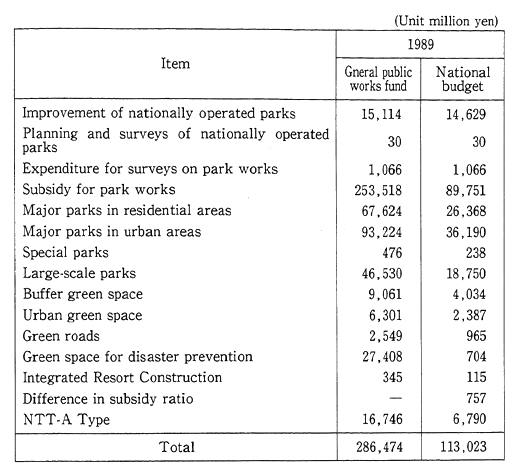
Notes: Surveyed by the Ministry of Construction.
In order to promote urban greening with the consent of inhabit-ants, greening agreements were concluded for 696 districts in 102 cities as of the end of fiscal 1988.
(5) Designation of Suburban Green Space
Under the Law for the Conservation of Suburban Green Belts in the National Capital Region and the Law for the Development of Conservation Areas in the Kinki Region, suburban green conservation areas measuring about 97,000 hectares in 24 districts are designated, and the filing of reports on acts which will affect the conservation of green spaces is obligated. Of those areas, there are 13 areas with a combined area of about 1,247 hectares, where the conservation is particularly urgent, and a system of permission is in force on certain acts of development.
(6) Designation of Scenic Zones
In order to maintain the scenery of cities with attempts to harmonize the favorable natural environment with building and other acts in areas abundant with natural elements, scenic zones are designat-ed under the City Planning Law, and under the regulations of prefec-tures and administrative ordinance-designated cities, regulations are exercised, such as the adoption of a system of permission on certain development acts and construction acts. The scenic zones designated as of the end of fiscal 1987 measured about 160,000 hectares in 225 cities across the country.
(7) Designation of Agricultural Zones
In order to conserve farmland with favorable environmental functions and functions as multipurpose reserves in built-up urban areas and contribute to the formation of a favorable urban environment, Category I and II areas of agricultural zones are designated in city planning under the Law Concerning the Agricultural Land, Etc., Reserved in Urbanization Promotion Areas, and as regards land in the areas of agricultural zones, the landowners are obligated to control them as farmland and the like. Controls are exercised, such as by subjecting the development of housing sites and the construction of new buildings to permission by the heads of municipalities. As of the end of fiscal 1987, the designated Category I and II agricultural zones measured about 27 hectares in 24 cities and about 331 hectares in 27 cities, respectively.
2. Conservation of Cultural Properties and Historic Environment
(1) Conservation of Historic Sites, Places of Scenic Beauty and Natural Monuments
Ancient tombs, shell mounds, the ruins of castles and other historically and scientifically valuable places are designated as historic sites, gardens and other scenic spots valuable in terms of art and appreciation as scenic sites, and scientifically valuable fauna and flora, geological features and minerals as natural monuments, and restrictions are imposed on change in their configuration. Designated as of the end of fiscal 1989 were 1,290 historic sites, 255 scenic sites and 914 natural monuments. The ownership of historic sites and so forth is made public, wherever particularly necessary, for the sake of their preservation, and in order to work for the utilization of those historic and other places, development and other protection projects (subsidized projects) are performed.
(2)Protection of Historic Structure Groups Preservation Areas
Of the areas designated by municipalities for conservation of old post towns, old castle towns and other groups of historic structures and their integrally valuable environment, those which are particularly valuable for the nation are selected as important historic structure group preservation areas, and the maintenance and repair of buildings, installation of facilities to prevent disasters, transfer to public owner-ship and other projects are subsidized. As of the end of fiscal 1989, 29 districts (in 25 municipalities) were designated.
(3) Conservation of historic Landscape in Historic Cities
In order to conserve areas which form and embody tradition and culture with the integration of historically significant ruins and the like with their surrounding natural environment, neighborhoods for conservation of historic features in Kyoto and 5 other cities and 1 town with a combined area of about 13,000 hectares are designated under the Law Concerning Special Measures for the Preservation of the Historic Natural Features of Ancient Cities. Of them, those neighbor-hoods which constitute pivotal parts (36 neighborhoods) with a com-bined area of about 4,537 hectares are designated as special historic features preservation areas.
Under the Law Concerning the Conservation of the Historic Natural Features and the Improvement of the Living Environment in Asuka Village, a neighborhood for conservation of Category I historic features with an area of 125.6 hectares and another neighborhood for conservation of Category II historic features preservation areas with an area of 2,278.4 hectares are designated in the city planning project.
In special historic features preservation areas, acts, such as the construction of new buildings and other structures, are subject to permission from prefectural governors, and the purchase of land is carried out. In order to work for the appropriate conservation of historical features in the purchased land, the development of facilities is subsidized under projects for conservation of historic features. In fiscal 1989, the planting of trees was taken and other development measures were taken with ¥51 million (with the project cost at ¥102 million). In historic features preservation areas) other than special area for conser-vation of historic features, restrictions are imposed, such as the obliga-tion to file reports with prefectural governors on th construction of new structures and other acts.
VI. Sound Utilization of Natural Environment
1. Hot Springs, Rest Facilities and Outdoor Activity Facility Areas
(1) Hot Springs
a. Hot Springs
Japan is a country prominent in the world with hot springs, which play an extremely important role as places for rest and recreation for the people. As of the end of fiscal 1988, there were 21,336 hot spring sources across the country (5,002 self-gushing sources, 9,759 motorized sources and 6,575 unused sources).
The Hot Spring Law is designed to protect those hot springs and work for their reasonable utilization. It is stipulated that in situations where hot springs are to be dug or additionally done so and situations where motorization is to be done, permission be received from prefec-tural governors, and that in situations where hot springs are to be used for public bathing or drinking purposes, permission be received from prefectural governors or the mayors of administrative ordinance-designated cities with public health centers. In 1988, permission was granted in 1,010 cases for the digging of hot springs, 76 cases for that of additional hot springs, 509 cases for the installation of motor and 2,046 cases for bathing or drinking purposes.
b. Hot Springs for the People's Rest
Of all hot springs, those from which utilization effects may be fully expected and which will be put to much use a sound and healthy places for rest are designated as "hot springs for the people's rest" by the Director-General of the Environment Agency. As of the end of December 1989, 77 places with a combined area of 11,517.36 hectares were designated as such.
In 1986, 7 "hot springs for the people's health care" (of all hot springs for the people's rest, those which are equipped with conditions that make it possible to encourage their use for health-care purposes with the cooperation of physicians) were designated, and in fiscal 1989, too, the development of open squares for picnic and other sites, path-ways and other facilities was subsidized.
(2) The National Lodges
The National Lodge is a facility which enables the people to comfortably stay and rest at small costs in places blessed with natural features and suitable for rest. As of the end of fiscal 1988, there were 307 such billets (Table 10-6-1), used by 8,450,000 people in fiscal 1988 (Table 10-6-2).
Table 10-6-1 Number of People's Lodges by Fiscal Year
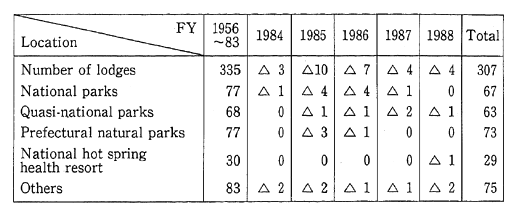
Remarks: Surveyed by the Environment Agency.
Table 10-6-2 Trends in Number of People Using People's Lodges
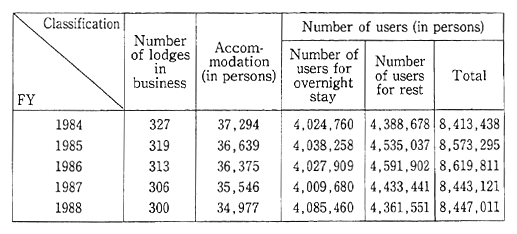
Remarks: Surveyed by the Environment Agency.
(3) National Recreation Center
The National Recreation Center is a facility which is available primarily for recreation, health and rest in a day'strip by residents near natural parks and other places suitable for rest. As of the end of fiscal 1988, there were 69 such places (Table 10-6-3) used by 2,620,000 people in fiscal 1988 (Table 10-6-4).
Table 10-6-3 Number of National Recreation Centers Established by Fiscal Year

Remarks: Surveyed by the Environment Agency.
Table 10-6-4 Trends in Number of People Using National Recreation Centers

Remarks: Surveyed by the Environment Agency.
(4) Pivotal Points of Activities for Conservation of Natural Environment--Communities for Communion with Nature and Native Living Things
The Communities for Communion with Nature and Native Living Things are designed to conserve places which are inhabited by dragon-flies, cicadas, frogs and other small animals and those where commu-nion may be held with the special natural features of home countries and at the same time to maintain places for the education of nature. They are also designed not only to develop facilities but to give explanations or guidance on nature with the participation of volunteers in attempts to promote the education of nature.
Depending on the diversity of natural features in given areas, the related projects are classified into an "inter-area development type," in which places for the observation of different types of nature in each given area will be linked by footpaths and so forth, and an "independent-development type," in which places for the observation of nature and so forth will be integrally developed as pivots of activities in each given area, and in each area, nature centers, observation facilities and facilities for the conservation of ecosystems will be developed. The plans call for the development of one such area in each prefecture, and in fiscal 1989, the development of 2 areas of the "inter-area development type" and 2 areas of the "independent-development type" were started.
(5) Areas for Utilization of Nearby Natural Features--Woods for Observation of Nature
The "nature observation woods" are pivotal model points which are developed to encourage communion with nature in the 3 major urban spheres, administrative ordinance-designated cities and others in light of the people's calls for communion with nearby natural features in major urban cities and their peripheries where the loss of natural features is striking. In order to deepen understanding about the mecha-nisms of nature and foster affection and morals toward nature, this project is designed to comprehensively develop nature centers, nature observation routes and other facilities which will serve as pivots for the observation of natural features. Under the plan, nature observation woods are to be developed in 10 districts across the country, and the development of 4 of them was carried over into fiscal 1989.
(6) Forests for Health Protection, Natural Recreation Forests
Of forests highly functional for conservation of the living environ-ment and for health care and rest, some were positively designated as "forests for health protection," and equipment and facilities for their utilization were subsidized. Besides, projects for the developments of forests for conservation of the natural environment and those for the comprehensive development of multipurpose protection forests were stepped up. "Protection forests for public health" and "protection for-ests for scenery," which are designed to conserve scenic spots measure about 570,000 hectares. In order to work for their appropriate location and the formation and conservation of the living environment, the development of forests (at 157 places), such as improvement in that of protection forests, and the purchase of forests (at one place ) were carried out. Besides, as part of the development of the infrastructure for protection forests for health. the development of facilities (at 34 places) was conducted.
As for natural recreation forests (at 92 places with a combined area of about 110,000 hectares) designated for areas in national forests which were considered suitable for the people's health. The offer of rest and recreation, periodic development, maintenance and control were conducted to positively display the functions of forests for health and rest.
While working for harmony with the multiphasic functions equipped to forests, the Human Green Plan under which wide variety of forest recreation facilities would be developed in national forests was promoted. In fiscal 1989, such areas were designated in Ajigasawa Town, Aomori Prefecture, and six other place.
2. Golf Links and Nature Conservation
In recent years, there has been concern about the posing of environmental issues by the construction of golf links. As of April 1986 there were about 1,600 golf links across the country with total are of 152,000 hectares, or 0.4% of the area of the national land (about 2.8 times the total area of city public parks). The number of newly con-structed golf links came to a peak in 1975 and later began to sharply drop, but there have been signs of a rise in the recent time (Fig. 10-6-5). The people's strong demand for playing golf may be cited as its back-ground.
The construction of golf links entails the felling of trees and bamboos broad in area and changes in land configuration, and their impacts on wildlife and other ecosystems and the natural environment, including scenery, were so significant that in national and quasi-national parks, golf links were removed from the category of facilities which fell under that of public-park projects in 1973, and the following year permission should not be granted for changes in land configuration when the development of golf links was planned in specified areas.
In the development of forests, controls are exercised under the Forest Law, and in 32 of 47 prefectures, guidelines and so forth are developed on the regulation of golf link construction and screening and guidance are conducted in regard to the forest retention rate and the like. In the latter half of the 1965-74 period, many prefectures curbed and froze the construction of golf links, but toward the end of the 1975-84 period, prefectures eased controls one after another. In the recent time, there have been prefectures, such as Nagano and Hyogo, which work for a strengthening of the controls.
Fig. 10-6-5 Trends in Number of Golf Links Established by Year

Note: Surveyed by Japan Golf Link Business Association
In terms of the maintenance of golf links, on the other hand, the utilization of pesticides and chemical fertilizer is commonly made to keep the lawns good in quality, and in recent years there have been mounting concerns about the impacts of pesticides on water in the region. In the midst of this situation, there occurred an accident in which "yamame" (Onchorhynchus masou) and other fish in Hokkaido's hatch-eries were affected by pesticides improperly sprayed at an upstream golf link in November 1989.
In light of the importance of pesticides used at golf links, it is necessary to step up guidance by administrative institutions and so forth in order to grasp the actual water quality around golf links and further work for the appropriate utilization of pesticides.
3. Environment of Rivers and Ports and Harbors
(1) Riparian Environment
In order to develop high-water level areas and offer residents places for rest and recreation as public space for water and green, measures for the appropriate utilization of the natural environment of rivers were promoted under Basic Programs for the Control of the Riparian Environment (formulated for 132 water systems as of fiscal 1989), whereas under projects designed to work for the formation of favorable waterside space (riverside road projects), watergates, cam-bers and so forth were developed. Riparian environment development projects designed to work for the utilization of rivers for recreation space (projects designed to promote the utilization of rivers) were carried out.
(2) Environment of Ports and Harbors
a. Green Land, Etc. at Ports and Harbors
In order to create a comfortable environment at ports and har-bors and offer places of rest for workers there and visitors to ports, the development of green land and so forth was conducted at Yokohama and other ports in fiscal 1989. Historic port and harbor development projects were carried out to conserve and use historic port and harbor facilities and work for the integrated development of their peripheral environment.
b. Marinas, Etc.
The marina is a facility which is expected not only to respond to increases in oceanic recreation activities but to create space charming and high in terms of amenity because of its eminent scenic beauty and high hydrophilicity, so that marinas are being developed from a perspec-tive of positively creating a comfortable environment, while working for harmony with the conservation of the natural environment.
VII. Greening Movement Evolution of Greening Movement
At a liaison council for the promotion of greening, made up by 9 ministries/agencies and chaired by the Chief Cabinet Secretary, attempt were made work for close mutual liaison among the related ministries and agencies and comprehensive and effective measures for greening were promoted. At the same time, attempts were also made to evolve a nationwide movement for the promotion of greening in accor-dance with the "Operating Policy for the Greening Promotion Move-ment" (approved by the council in April 1983), "Toward Building of Communities Full of Green" (approved by the council in January 1985) and "Aiming at the Building of a Nation Full of Green and Flowers and with Charm" (approved by th council in July 1989). By implementing the following measures, efforts were made for a further evolution and settling of the movement.
# Promotion of the "Movement for Development of Woods with Singing Birds," etc.
# Promotion of town building with flowers and green
# Execution of projects for the promotion of greening in the school environment
# Promotion of the national land greening movement, etc.
Chapter11. Surveys And Researches On Environment Protection
I .Studies by National Institute for Environmental Studies
1. Strengthening of Research System
The National Institute for Environmental Studies was estab-lished in the academic city of Tsukuba March 1974 as an agency attached to the Environment Agency in order to play the leading role in environmental studies in Japan.
Efforts have since been made for a strengthening of the research system in order to replenish research activities. In fiscal 1989, the International Research Cooperation Official and the Chief Research Official (in charge of oceans) were newly established and the Substratos-pheric Research Office and the Molecular Biological Research Room were newly established.
Organizationally, the institute consisted of two divisions and 41 offices in 10 departments with a combined staff of 250 members as of the end of fiscal 1988.
2. Replenishment of Research Activities
(1) Administrative Work on Researches
In fiscal 1989, "current researches" were made on 163 subjects and "special researches" and "comprehensive special researches" were made on 12 subjects. Of them, "special researches" are promoted with the cooperation of related in-house departments and with the involve-ment of researchers outside the institute, and by coupling with on-the-spot field surveys with experimental researches with the use of large facilities, they are systematically carried out as "comprehensive pro-jects" with several years as a term.
The subjects of "special researches" conducted in fiscal 1989 are as follows :
[1] A study on the behavior of hazardous chemicals in the soil and underground water sphere (fiscal 1985-89)
[2] A study on air pollution an archipelagic dimension accompanying the process of cloud physics (fiscal 1986-90)
[3] A study for the development of parametric plants in the atmo-spheric environment with biotechnology (fiscal 1966-90)
[4] A study on the assessments of the effects of eutrophication on ecosystems in the bays (fiscal 1986-90)
[5] A study for clarification of the chemical environment of high technology (fiscal 1987-91)
[6] A study on methodologies for the functional assessment and new control of waters in terms of the environmental assimilating capacity.
[7] An experimental study on the assessment of the effects of air pollutants, primarily particulate matter, on living bodies (fiscal 1988-92)
[8] A study for the development of environmental health monitoring methodologies associated with the environmental stress and health in major urban spheres (fiscal 1988-92)
[9] A basic study on changes in the stratospheric ozone layer and their effects on the environment (fiscal 1988-93)
[10] A study on methodologies for the comprehensive assessment of the environment for formulation of traffic pollution prevention pro-grams in intercity urban spheres (fiscal 1990-92)
[11] A study on the effects of long-term exposure to chemicals in the water environment on,multiple ecosystems (fiscal 1989-94)
As one of the "comprehensive special studies on global warming," a "study for clarification of the environmental dynamics of air compo-nents associated with global warming" (fiscal 1989-93) was conducted.
(2) Administrative Work on Environmental Information
The database associated with the environmental quality was replenished, such as by the magnetic-tape editing and recording of a variety of measured data on Japan's environment, centering on the air and water quality. In addition, the Environment Agency works as contact points for foreign countries under the International Referral System for Sources of Environmental Information (INFOTERA) of the U. N. Environment Program (UNEP).
II. Surveys and Researches on Environment Protection
1. Surveys and Researches at Present
The sectors in which scientific and technological researches are conducted to promote measures for environment protection may rough-ly be classified into a sector associated with technology for the preven-tion of pollution, the sector associated with the development of surveil-lance and monitoring technology, a sector associated with the grasping and assessment of the effects of environmental pollution, and a sector associated with the conservation of the natural environment.
Those studies are broadly promoted by the State, local govern-ments and the nongovernmental sector at present.
In stepping up those studies, it is necessary for the State to work for close coordination among the related research institutions and researchers now that the related sectors of science and technology are broad and the research sectors are closely tied in with one another. For this reason, the Environment Agency appropriates in a lump sum the costs of researches and studies on the prevention of environmental pollution undertaken by the research and study institutions of the related ministries and agencies and others (excluding those placed under the jurisdiction of universities and the experiment and research institu-tions attached to them) and then allocates those funds for a comprehen-sive coordination of the surveys and researches which form the basis for promotion of national policy measures, such as the establishment of various criteria. In addition, the agency carries out surveys and researches with the Coordination Fund for Encouragement of Compre-hensive Surveys and Researches for Conservation of the Environment in order to efficiently take emergent actions.
In regard to the development of large-scale and comprehensive technologies, or those for which there are particularly significant admin-istrative needs, or that of drastically new technologies which would encourage non-pollution, efforts are made for their promotion by organ-izing large-scale projects with the involvement of the private sector or the formulation of subsidization measures to the private sector.
The environmental institutions of local governments carry out surveys and researches which are closely tied in with the environmental administration of their respective areas, so that the Environment Agency continues to promote their activities.
2. Environmental Researches and Studies by National Institutions
(1) Outline
The fund appropriated in a lump sum in the Environment Agency in fiscal 1989 for environmental researches and studies by national institutions was ¥2,283,100,000 for 105 themes (¥2,343,620,000 for 107 themes in the preceding fiscal year), and those researches and studies were conducted by the 46 institutions which belonged to 13 ministries and agencies, including the National Police Agency, Hokkaido Develop-ment Agency, Agency of Science and Technology, Environment Agency, Ministry of Finance, Ministry of Education, Ministry of Health and Welfare, Ministry of Agriculture, Forestry and Fisheries, Ministry of International Trade and Industry, Ministry of Transport, Ministry of Posts and Telecommunications, Ministry of Labor and Ministry of Construction.
In respect of environmental researches and studies with the fund, efforts have been continued to organize and promote comprehensive research projects in each research area with consideration given not only to immediate problems but to the formation of the basis for measures in a long-term perspective.
(2) Comprehensive Research Projects
In fiscal 1989, 10 comprehensive research projects were carried out as stated below :
a. Study on the prevention of air pollution
b. Study on the sophistication of effluent treatment
c. Study on the prevention of marine, lake and reservoir pollution
d. Study on the treatment of wastes and recycling technology
e. Study on the management and conservation of the natural envi-ronment
f. Study on the development of planning methodologies for the conservation of the urban environment
g. Study on the prevention and assessment of noise and vibration
h. Study on the sophistication of monitoring technology on environ-mental pollutants
i. Study on the assessment of the effects of environmental pollut-ants
j. Study on the conservation of the global environment
In addition the aforementioned 10 comprehensive research pro-jects, researches were conducted on 4 themes in fiscal 1989, including the clarification of mechanisms for changes in the quality of underground water in cultivated and forest areas, and projections and monitoring methods on the proliferation of environmental pollutants from high-technology industries.
3. Surveys and Researches with Fund for Promotion and Coordination of Comprehensive Surveys and Researches on Environment Conservation
The principal surveys and researches supported by the coordina-tion fund are as follows :
The Environment Agency conducted a survey on emergency measures for the conservation of areas for the propagation of Steller's albatrosses on Torishima Island and a survey on health effects, such as by artificially increased ultraviolet rays. The Environment Agency and the Maritime Safety Agency carried out a survey on response to interna-tional conventions on the control of massive oil spills. The Environment Agency, Ministry of Construction and Ministry of Transport conducted a survey and research for air pollution prevention projects in major urban areas. The Environment Agency, Ministry of Health and Welfare, Ministry of Agriculture, Forestry and Fisheries and Ministry of Con-struction carried out a survey and research for projects for the creation of a comfortable environment. The Environment Agency and Ministry of Construction conducted a basic survey for studies on field testing methods on the utilization in the open system of genetically modified organization. The Environment Agency, Ministry of Health and Wel-fare and Ministry of Agriculture, Forestry and Fisheries carried out a fact-finding survey on TPT compounds.
Moreover, the Environment Agency carried out researches on the sophistication of the ozone layer observation system. The Environment Agency and Ministry of International Trade and Industry conducted an emergency survey on measures to strengthen the protection of the ozone layer. The Environment Agency, Ministry of International Trade and Industry and Meteorological Agency carried out studies on global warming for response to the IPCC. The Ministry of Transport carried out a survey on the effects on global warming of the consumption of fuels for transport.
4. Researches and Studies by Local Governments
The environmental research and study institutions of local gov-ernments, playing the role of a scientific endorser for environmental administration, broadly carry out surveillance and monitoring, analyses, surveys and the collection of basic data. They also actively promote research activities on regional issues.
In order to maintain close ties with those local environmental institutions and to work for an efficient promotion of their researches, the Environment Agency held th meetings of the chiefs of those institu-tions and work d for the promotion of information exchanges among researchers, such as by holding meetings where researches on the conservation of the environment could meet and present their findings of the latest surveys and researches.
In fiscal 1989, th National Institute for Environmental Studies public appealed local environmental pollution experiment and research institutes for contributions and carried out joint studies on 20 subjects.
Chapter12. Promotion Of International Grappling With Environment Conservation
I. Grappling Questions on Global Environment
1. In recent years, questions on the global environment have come to the fore and there is a rapidly mounting climate for international grappling against the background of further rises in the levels of economic performance primarily in developed countries, poverty and rapid rises in population and its concentration in cities primarily in developing countries, and the expansion of international interdepen-dence, among others.
Questions on the global environment are dealt with primarily by the United Nations Environment Program (UNEP), followed by such international institutions as the United Nations Educational, Scientific and Cultural Organization (UNESCO), World Meteorological Organiza-tion (WMO) and the United Nations Food and Agricultural Organiza-tion (FAO). They are also dealt with in a diversified manner by the Organization for Economic Cooperation and Development (OECD), International Congress of Scientific Unions (ICSU) and other interna-tional institutions and the government of each country.
Particularly in fiscal 1989, when the Arche Summit was held in Paris in July, the global environment was taken up as a main item on the agenda. In September, the Tokyo Congress on Conservation of the Global Environment was held. In November, the Ministerial Conference on Air Pollution Climatic Change was held in the Netherlands. With those and other international meetings held one after another, the year turned out to be what could well be described as the "first year for the global environment."
2. In Japan, the Council on Global Environmental Problems (chair-ed by former Foreign Minister Saburo Ohkita) has been held since September 1980 under the sponsorship of the Director-General of the Environment Agency with the participation of men of learning and experience, and the views presented at this council have been released four times in the form of a report. The views compiled in April 1982 led to the establishment of the United Nations' World Commission on Environment and Development (WCED). In June 1988, views on Japan' s concrete grappling in response to the WCED report were released as they were compiled in the form of the fourth report.
The 1988 edition of the White Paper on the Environment ap-proved by the Cabinet in May 1988 was subtitled "Japan's contributions to the conservation of the global environment" and the global environ-ment was taken up as its main theme.
In fiscal 1989, the Global Environment Conservation Planning and Promotion Headquarters established in the Environment Agency in August 1987 released in the form of an interim report the agency's thoughts about the way Japan should grapple with this issue in May. Also in May, the Cabinet orally approved the opening of a Conference of Related Ministers on Conservation of the Global Environment which would be composed by 19 cabinet ministers, the Minister in Charge of the Global Environment and related executives of the Liberal Demo-cratic Party. The conference participants reached agreement on mea-sures to conserve the global environment in May and on the comprehen-sive promotion of research and monitoring and technical development for conservation of the global environment in June.
In June, they agreed :
[1] --while considering it necessary to positively play a role commen-surate with Japan's international position in the conservation of the global environment--to positively take part in the international frame-work for conservation of the global environment as the basic direction of the immediate policy measures,
[2] To promote research and monitoring on the conservation of the global environment,
[3] To strive for the development and propagation of technology which contributes to the conservation of the global environment,
[4] To expand official development aid (ODA) to support developing nations' efforts for conservation of the global environment,
[5] To strength environmental considerations in the offer of ODA and other aid, and
[6] To strive to see to it that socioeconomic activities may be evolved in methods to reduce loads on the global environment.
The October agreement featured an ascertainment of the basic direction for the comprehensive promotion of research and monitoring and technical development on the conservation of the global environ-ment. For their steady promotion, it was agreed (1) to formulate a comprehensive promotion program on research and monitoring and technical development on the conservation of the global environment each fiscal year at the Conference of Related Ministers and to receive reports on the results, and (2) for the Environment Agency to designate an "over-the-counter" office for general information on the conservation of the global environment and for related ministries and agencies to keep in touch with the "over-the-counter" office of the Environment Agency and designate heir respective "over-the-counter" information offices.
In July, the Director-General of the Environment Agency was designated as Minister in Charge of the Global Environment. The minister takes charge of the coordination of administrative work under the jurisdiction of each branch of administration in order to enable the government to smoothly promote as one body the measures formulated to conserve the global environment.
II. Bilateral Cooperation Under Conventions, Etc.
(1) Activities Based on U.S.-Japan Environmental Protection Cooperation Agreement
Since the conclusion of the U.S.-Japan Environmental Protection Cooperation Agreement in August 1975, the joint planning and coordina-tion committee at the ministerial level has held meetings to discuss a broad range of environmental issues according to the agreement. In May 1989, the ninth meeting was held in Washington on a visit to the United States of Masahisa Aoki, the then Director-General of the Environment Agency to exchange views with Wiliam K. Reily, director of the U.S. Environmental Protection Agency.
According to the agreement, 15 projects are established, and the exchange of information, the holding of conferences and the exchange of experts are stepped up.
(2) Activities Under the U.S.-Japan Cooperative Program in Natural Resources (UJNR)
This is a panel of the group of specialists on conservation, recreation and parks established under the U. S.-Japan Cooperative Program in Natural Resources in 1964. It has hold 15 meetings.
The 15th meeting was held in Tokyo in October 1989 to discuss environmental protection at facilities to use natural parks.
(3) Activities Based on U.S.-Japan Science and Technology Agreement
The new U. S. Science and Technology Agreement was concluded in June 1988 to supersede the old agreement which was concluded in 1980. In Annex 1 to the agreement, seven sectors of cooperation, includ-ing earth science and the global environment, are taken up. At present, The exploration of cases of cooperation between the two countries, among others, is conducted.
(4) Activities Based on Agreement between the Government of Japan and the Government of the Federal Repulic of Germany on Cooperation in the Field of Science and Technology
The panel on technology for conservation of the environment based on Agreement between the Government of Japan and the Govern-ment of the Federal Republic of Germany on Gooperation in the Field of Science and Technology in 1974 was held in Bonn in December 1989. Views were exchanged on the general trend of research and develop-ment in the sector on technology for the conservation of the environ-ment in both countries, and on the existing state of research and development on the existing nine themes of cooperation and the status of cooperation were exchanged.
(5) Major Activities Based on Science and Technology Agreements With Other Countries
As part of the activities on "Amenities in the Urban Environ-ment," a cooperation project based on the Agreement between the Government of the French Republic and the Government of Japan on Cooperation in Science and Technology, the Fifth Japan-France Amen-ity Conference was held from October to November 1989.
(6) Activities Based on Migratory Bird Protection Convention
The Fifth Japan-Australia Consulative Meeting on the Protection of Migratory Birds, Etc. based on the Agreement between the Govern-ment of Australia and the Government of Japan for the Protection of Migratory Birds and Birds in Danger of Extinction and Their Environ-ment Etc. concluded in 1981 was held in Tokyo in June 1989. The First Japan-Soviet Conference on the Protection of Migratory Birds, Etc. based on the Japan-Soviet Migratory Concention, Etc. concluded in 1988 was held in Moscow in September 1989.
III. Environmental Cooperation with Developing Countries
In developing countries, environmental issues crop up due to desertification, population pressures including decreases in tropical forests and the inappropriate control of environmental resources. Besides, in conjunction with the evolution of socioeconomic develop-ment, they are confronted with environmental pollution of the sort which is experienced by developed countries.
Developing countries are grappling with the development of the machinery for environmental administration and environmental legisla-tion in parallel with the development. Normally, as the technological and economic infrastructure is inadequate, there are many cases in which they are in need of aid from developed countries in order to efficiently promote measures for conservation of the environment. In particular, mounting expectations have in recent years been put on Japan which has much experience in measures to conserve the environ-ment, and the number of calls for technical cooperation in the field of environment from Japan has increased in recent years.
For this reason, environmental cooperation is stepped up as part of the technical cooperation of the Japan International Cooperation Agency (JICA), and studies are made on measures to promote coopera-tion in an efficient manner and on the basis of the results, the upbringing and maintenance of men of talent are grappled with.
Cooperation was rendered in fiscal 1989 as follows :
(1) Technical Cooperation
(a) Development Surveys
[1] Study on Water Pollution Control Plan for Lake Ypacarai and its Basin in Paraguay
In order to study the existing state and sources of water pollution in Lake Ypacarai in Paraguay and make proposals on comprehensive measures to cope with water pollution in its basin, technical cooperation was rendered from January 1988 in association with measures to cope with water pollution in the lake, and the final report was submitted in August 1989.
[2] Study on Air Pollution Control Plan in Bogota City
In order to study the existing state of air pollution in the Bogota City, Colombia, formulate measures against pollution and make pro-posals, technical cooperation was rendered in association with measures to cope with air pollution from February 1989.
[3] Study on the Air Pollution Control Plan of Stationary Sources in the Metropolitan Area of the City of Mexico
As regards air pollution in the metropolitan area of the City of Mexico, a preliminary study team on development study was dispatched in August 1989 to formulate a program to cope with air pollution which would center on measures against stationary sources.
[4] Study on Water Pollution Control Plan for Lake Poyang in China Lake Shenyang, China
A preliminary study team on development study was dispatched in December 1989 to survey the existing state of water pollution in Lake Poyang, China, and the sources of pollution and to formulate a program for the conservation of the quality of the lake water.
(b) Acceptance of Trainees
Many developing countries are directly confronted with an abso-lute lack of administrators and technicians who have expertise and experience in the conservation of the environment as a whole.
For this reason, the Japan International Cooperation Agency (JICA) carries out group training with the cooperation of the Environ-ment Agency, Ministry of Construction, Ministry of Health and Welfare and other organizations.
In fiscal 1989, training was conducted on environmental adminis-tration (10 trainees from 10 countries), environmental engineering (water pollution control) (11 trainees from 11 countries), environmental engineering (air pollution control) (12 trainees from 11 countries), sewer-age technology (15 trainees from 13 countries), disposal of waste (10 trainees from 10 countries), measures on the industrial environment (10 trainees from eight countries) and prevention of industrial pollution (six trainees from four countries), among others. As occasion arises, the agency also carries out individual training in response to the needs of developing countries with the focus on specific issues.
(c) Dispatch of Experts
In order to transfer technology in the environmental sector to the administrative, research and other institutions of developing countries, experts were dispatched to the Republic of Korea, Thailand, Malaysia, Indonesia, Mexico and other countries.
(d) Joint Study Project
A survey team was dispatched in November 1989 to cooperate in studies for conservation of the water quality in the basin of the Han River in the Republic of Korea, and cooperation in the studies began in February 1990.
Joint studies were conducted with China for a clarification of mechanisms for desertification.
(2) Grant Capital Assistance
Grant Capital Assistance was made in the following sectors in fiscal 1989.
(a) Environmental Research and Training Center in Thailand
A Cabinet decision was made for grant capital assistance in the establishment of a center which would conduct research, training and monitoring in the environmental sector as a package in June 1989, and the exchange notes were signed in July 1989 to start construction in March 1990.
(b) Sino-Japanese Friendship Environment Conservation Center
For grant capital assistance in the establishment of a center which would have environmental monitoring, information, applied research and other divisions, a basic-design survey team was dispatched in March 1990.
(3) Onerous Fund Cooperation
In fiscal 1989, onerous fund cooperation was offered in the devel-opment of sewer systems and other environmental sectors, let alone the following cases.
[1] Metro Cebu Development Project (Waste Disposal and Other Project) in the Philippines
The projects were designed to offer a fund for trash processing projects for Cebu City and its peripheries to work for improvements in the urban environment. The exchange notes were signed in October 1989 and a loan contract was signed in March 1990.
[2] Indonesia Sector Program Loan
The Indonesia Sector Program Loan was designed to carry out about 14,000 hectares of afforestation as part of support to major sectors. The exchange notes were signed and a loan contract was signed in December 1989.
(4) Dispatch of Survey Teams for Formation of Projects
In expanding and strengthening aid in the environmental sector, it has become necessary for Japan to talk with developing countries about various measures and strive to find suitable cases of aid.
From this perspective, the following project formation teams were dispatched in fiscal 1989.
[1] Mexico Project Formation Team
A survey team was dispatched in June 1989 to come to grips with a Mexican request for Japan's cooperation in measures to cope with air pollution in Mexico City.
[2] Southeast Asia Environment Mission
A survey team was dispatched in October 1989 to hold policy talks with four Southeast Asian nations (Malaysia, Thailand, Indonesia and the Philippines) and exchange views on the discovery of suitable cases.
[3] Eastern Europe Environment Mission
A survey team was dispatched to four East European nations (Poland, the German Democratic Republic, Czechoslovakia and Hungar-y) to come to grips with environmental conditions.
(5) Replenishment of Considerations to the Environment
The Overseas Economic Cooperation Fund which took charge of yen loans established a study committee on environmental questions in April 1989 and released a guideline on considerations to the environment in November.
The Japan International Cooperation Agency (JICA) is formulating a guideline on considerations in each environmental sector. It established an Environment Office in August 1989 to strengthen the system of translating environmental considerations into action.
IV. Promotion of Public Information Overseas, Etc.
In the process of promoting environmental policy, Japan may be described as having greatly contributed to the promotion of environmen-tal policy by means of exchanges with foreign countries and the exchange of information, as it used to develop it by learning about their knowledge and experience.
On the other hand, Japan has had quite unique experience in terms of damage caused by environmental pollution and acquired much knowledge and experience in the process of making efforts for their solution, and we consider that the offer of findings to foreign countries will contribute to the deepening of understanding about Japan's environ-mental policy and to the encouragement of international exchanges. As part of this endeavor, the White Paper on the Environment, entitled Quality of the Environment in Japan, the monthly journal Japan Envi-ronment Summary and other periodicals are translated into English and published for distribution to the governments of foreign countries, international institutions and various environment-related institutions, among others, to positively evolve public-information activities.
Chapter13. Environmental Protection By Local Governments And Private Sector
I. Environment Protection by Local Governments
On environment protection, local governments not only take direct charge of regulation, guidance and the surveillance, monitoring and control of environmental pollution, but also plays an important role as the entities of carrying out various projects to cope with environmen-tal pollution and projects for the conservation of the natural environ-ment.
Local environment conservation measures are implemented with due consideration to the local natural features, state of the environment, and socioeconomic trends. A number of prefectures and administrative ordinance-designated cities form local environment control programs for the planned and systematic promotion of those local environment conservation measures. And they also develop systems of information on the environment.
The institutionalization of environment impact assessments is studied, measures to cope with domestic waste water are promoted and measures against livelihood noise are implemented. Measures for the conservation of greenery, the building of an amenity environment with the promotion of planting trees, trust systems and so forth, and mea-sures to deal with discard cans are also carried out.
1. Present State of Organizations and Staff Officials in Charge of Local Environmental Administration
As of October 1, 1989, the number of staff officials in charge of environmental pollution in prefectures and administrative ordinance-designated cities (excluding those associated with wastes management and sewer systems) was 7,447.3, and the numbers of full-time staff officials and concurrent staff officials by organization in charge of environmental pollution is given in Table 13-1-1. The number of staff officials in charge of nature conservation was 1,550.5, as indicated in Table 13-1-2.
Table 13-1-1 Full-time and Concurrent Staff Officials in Prefectures and Administrative Ordinance-Designated Cities by Organization in Charge of Environmental Pollution
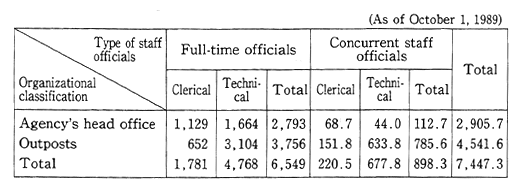
Remarks:1. Surveyed by the Environment Agency.
2. The figures for concurrent staff officials are those for which the number of staff officials who are also in charge of another line of administrative work is proportionally distributed, depending on the volume of their work.
3. The number of staff officials who deal with wastes and sewer systems are excluded.
Table 13-1-2 Full-time and Concurrent Staff Officials in Prefectures and Administrative Ordinance-Designated Cities by Organization in Charge of Nature Protection
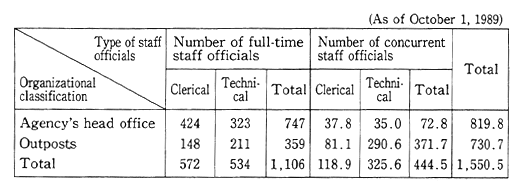
Remarks:1. Surveyed by the Environment Agency.
2. The figures for concurrent staff officials are those for which the number of staff officials who are in charge of another line of adminis-trative work is proportionally distributed, depending on the volume of their work.
As of October 1, 1989, 137 municipalities had bureaus, depart-ments and divisions (offices) specialized to environmental pollution. In addition, 413 municipalities had subdivisions (squads) specialized to environmental pollution and another 299 municipalities had only staff officials in exclusive charge of environmental pollution. All those municipalities accounted for 26.0% of all municipalities in the country. Incidentally, 61 municipalities had environmental pollution research institutes, environmental pollution centers and other outpost agencies.
Table 13-1-3 Number of Staff Officials in Charge of Environmental Pollution in Municipalities (Full-time)
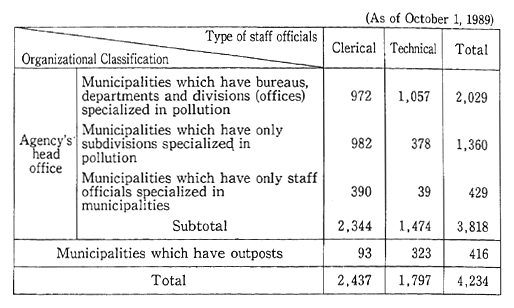
Remarks:1. Surveyed by the Environment Agency.
2. The number of staff officials in charge of wastes and sewer systems is excluded.
Next, the total number of municipal staff officials in exclusive charge of environmental pollution was 4,234 as of October 1,1988, and the number of municipal staff officials by organization in charge of environmental pollution is shown in Table 13-1-3.
2. Enactment of Decrees
The environment conservation-related decrees of local govern-ments may be roughly classified into (1) decrees for the prevention of environmental pollution, (2) decrees for the conservation of the environ-ment, (3) decrees for the conservation of the natural environment (nature protection) and (4) other decrees related to the conservation of the environment (including decrees on environmental impact assess-ments).
The decree for the prevention of environmental pollution repre-sents the basis of the local government policy toward the prevention of environmental pollution. It is also necessary for the comprehensive promotion of local environmental-pollution prevention measures. A decree for the prevention of environmental pollution is enacted by 54 prefectures and administrative ordinance-designated cities.
The decree for the conservation of the environment is the basic decree with which the local government comprehensively works for conservation of the environment, and as of October 1, 1989, it was enacted by seven prefectures and one administrative ordinance-designated city.
The decree for conservation of the natural environment (nature protection) represents the basic guideline on the conservation of the natural environment by the local government and was enacted by 45 prefectures and one administrative ordinance-designated city. Other environment conservation-related decrees include a decree on natural parks, a decree to cope with studded tier pollution, a decree for the prevention of eutrophication in lakes and reservoirs, a decree for controls on the intake of ground water, a decree for greening, a decree for the prevention of dispersed cans and so forth.
The enactment of environment conservation-related decrees by municipalities is shown in Table 13-1-4.
Table 13-1-4 Enactment of Ordinances Associated with Environment Conservation in Municipalities

Remarks: Surveyed by the Environment Agency.
3. Environmental-Pollution Prevention Agreements
The number of agreements made for pollution prevention from October 1988 to September 1989 was 2,671, and that of accords in effect as of September 30, 1989, was 33,294.
Agreements for pollution prevention were made in this manner:
[1] Since the agreements made it possible to appropriately carry out elaborate measures for pollution prevention in response to the geograph-ical and social conditions of the given districts, and
[2] Since businesses were aware that it would be indispensable to secure agreement from local residents for their facilities in order to assure a smooth execution of the corporate performance.
Table 13-1-5 Number of Establishments Concluding Environmental Pollution Prevention Agreements by Line of Business
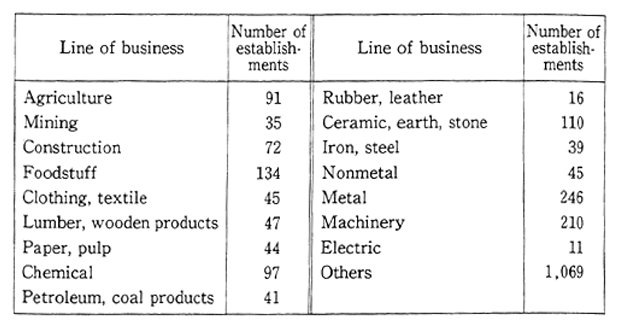
Remarks:1. Surveyed by the Environment Agency.
2. The table represents a tabulation of agreements reached from October 1, 1988, to September 30, 1989.
Table 13-1-6 Contents of Pollution Prevention Agreements

Remarks:1. Surveyed by the Environment Agency.
2. The table represents a tabulation of agreements concluded from October 1, 1988, to September 20, 1989.
Table 13-1-7 Citizens' Participation in Pollution Prevention Agreements

Remarks:1. Surveyed by the Environment Agency.
2. The table represents a tabulation of agreements concluded from October 1, 1988, to September 30, 1989.
The counterparts with which agreements are made are shown by line of business in Table 13-1-5 and by type of measure for pollution prevention in Table 13-1-6.
The number of pollution prevention agreements made with the participation of residents as related parties and witnesses is shown in Table 13-1-7.
4. Costs for Measures Against Environmental Pollution
The funds laid out by local governments for measures to cope with environmental pollution by local governments (including those associated with local public enterprises) came to ¥3,396.3 billion (¥1,011. 7 billion by prefectures and ¥2,384.6 billion by municipalities) in fiscal 1988, down ¥15.3 billion or 0.4% from the preceding fiscal year (down ¥55 billion for prefectures and up ¥39.7 billion for municipalities), or 0. 4% (Table 13-1-8).
A check of the breakdown of costs for measures to cope with environmental pollution indicates that costs for pollution prevention amounted to ¥3,083.3 (with a component ratio of 90.8%), followed by costs for compensation to health damage caused by the environment pollution to ¥115.1 billion (3.4%).
A check of the breakdown of costs for measures to cope with environmental pollution reveals that costs for the development of sewer systems came on top of the list with ¥2,443.4 billion, accounting for 71. 9% of all funds for measures to cope with environmental pollution, and they were followed by costs for projects for the development of waste treatment facilities with ¥399.9 billion (with a component rate at 11. 8%).
II. System for Prevention of Environmental Pollution in Private Sector
1. Execution of Environmental-Pollution Prevention and Control System by Entrepreneurs
In order to develop a system for the prevention of environmental pollution in factories, the Law for the Establishment of Organizations for Pollution Control in Specified Factories was enacted in June 1971.Under this law, specified factories were obligated to assign environmental-pollution prevention overseers, who would oversee administrative work on pollution prevention, and environmental-pollution prevention controllers, who were equipped with necessary expertise and skills, and so forth, starting September 1972. Organiza-tions for pollution prevention are developed at about 20,000 specified factories.
Table 13-1-8 Settled Accounts for Municipal Pollution Measures (FY 1988)
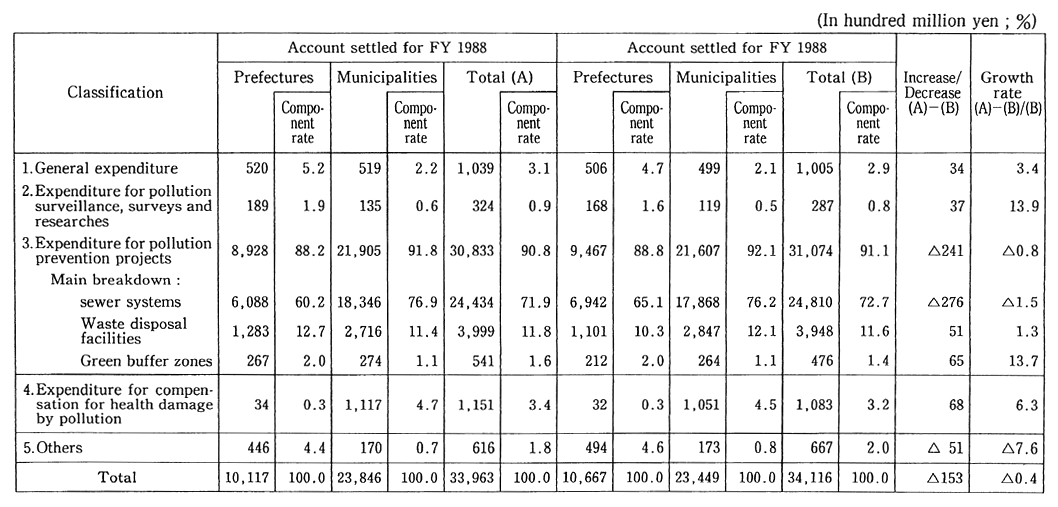
Remarks: 1. Surveyed by the Environment Agency.
2. The settled accounts are those for which duplications between prefectures and municipalities are deducted.
According to the surveys made by prefectures, the number of designated environmental-pollution prevention overseers (including cor-porate representatives) was about 11,700 and that of environmental-pollution prevention custodians and so forth (including proxies) was about 38,400 as of the end of March 1989.
For the acquisition of qualifications as environmental-pollution prevention custodians and so forth under this law, national examina-tions and lectures for the authorization of qualifications are performed. At present, the total number of qualified persons is about 386,328.
Appendices
Appendix1. Organization and Functions of the Environment Agency
1. Background
Thanks to the establishment, in July 1970, of the Headquarters for Countermeasures for Environmental Pollution (headed by the Prime Minister) and to the subsequent enactment and consolidation of anti-pollution legislation by the 64th(November-December1970) and the 65th (December 1970-May 1971) Diet Sessions, the pollution control adominis-tration of Japan was markedly strengthened. However, the wide distri-bution of pollution control functions among a number of ministries and agencies created serious bottlenecks in the enforcement of comprehen-sive anti-pollution measures.
In view of the above, Prime Minister decided to establish an Environment Agency with a view not only to controlling environmental pollution but also to promoting adoministrative measures for overall conservation of nature. As apreliminary step an Inter-agency Prepara-tory Committee for the Establishment of an Environment Agency, composed of the administrative vice-ministers of all the ministries and argencies concerned was instituted under th chairmanship of Director-General of the Prime Minister's Office. The work of this Committee rapidly led to the establishment of an independent agency for environ-mental protection and enhancemant. The lines of thinking underlying this move are summarized as follows:
a. The responsibilities and concern of the Environment Agency should not be limited merely to the pollution control, rather, the Agency' s administrative jurisdiction should cover all spheres of environmental protection including the nature conservation.
b. Regulatory measures, such as the setting of standards, and the monitoring and surveillance of pollution, which have been spread over a number of ministries and agencies, should be concentrated under a single command,an Environment Agency.
c. in view of the vital importance of scientific research and investigation relating to pollution control, a National Institute for Environmental Studies should be established.
A Law for the Establishment of the Environment Agency was approved by the Cabinet on February 16, 1971 and passed the Diet on May 24,Under the Law, the Environment Agency came into being on July 1, 1971.
2. Administrative Responsibilities
The Environment Agency is responsible for overall promotion of environmental protection with a view to ensuring a healthy and civilized life for the people of Japan. The following matters are under its jurisdic-tion.
a. General
These include the planning, drafting and promotion of basic policies relating to protection of the environment; overall coordination of the various branches of the Government responsible for environmen-tal protection; coordination of budgetary policies for pollution control-related expenditures; and centralized management of appropriations for environmental research and development. The Agency's administrative structure is designed to increase its effectiveness as an overall coordina-tor.
b. Nature Conservation
The Agency has under its jurisdiction enforcement of the Nature Conservation Law, the Natural Parks Law, the Wildlife Protection and Hunting Law, the Law relating to the Regulation of Transfer of Special Birds, and the Law for the Regulation, etc., of the Transfer of Endan-gered Species of wild Fauna and Flora.
c. Pollution Control
Matters coming under the jurisdiction of the Agency include establishment of environmental quality standards, enforcement of the Air Pollution Control Law, the Water Pollution Control Law and other laws relating to environmental pollution control.
3. Organization
a. Director-General of the Environment Agency
The head of the Environment Agency is called a Director-General and is appointed to the Cabinet with the rank of a Minister of State.
When the Director-General deems it necessary for the protection of the environment, he has the power to request information or explana-tions from the heads of other administrative agencies. He is also empowered to make recommendations to them with respect to impor-tant matters. When the situation so warrants, he can recommend the Prime Minister that steps be taken under Article 6 of the Cabinet Law to direct and supervise administrative agencies in accordance with the policies decided upon by the Cabinet.
b. Subdivisions and Ancillary Bodies
The Agency comprises 4 bureaus--Planning and Coordination, Nature Conservation, Air Quality and Water Quality--and 2 depart-ments--Grobal Environment and Environmental Health--in addition to Minister's Secretariat. The Agency is subdivided into 24 divisions, 9 offices and etc., employing a total of 921 civil service personnels as of March 1991 (planned).
As ancillary bodies to the Agency, the Training Institute for Environmental Pollution Control undertook its work on March 1, 1973, and the National Institute for Environmental Studies was established on March 15, 1974. But the Training Institute for Environmental Pollution Control was absorbed into the National Institute for Environmental Studies on July 1, 1990 so as to integrate environmental training and environmental studies. The Pollution-related Health Damage Compen-sation Grievance Board was established on September 1, 1974 and the National Institute for Minamata Disease was established on October 1, 1978. In addition, there are in operation the Central Council for Environ-mental Pollution Control, the Nature Conservation Council, the Seto Inland Sea Environmental Conservation Council, and the Special Certifi-cation Council for Minamata Disease.
4. Administrative Responsibilities of the Bureaus
a. Minister's Secretariat
The Secretariat is in charge of personnel administration, account-ing, matters relating to public information, general affairs of the Central Council for Environmental Pollution Control and other matters relating to general coordination of the Agency's service. Regional affairs officers are responsible for surveys, and collec-tion and filing of data with regard to the environmental situation in the prefectures. They also act as liaison officers with the Management and Coordination Agency's Regional Administrative Inspection Bureau which perform works on behalf on the Environment Agency.
b. Planning and Coordination Bureau
The primary responsibilities of this Bureau are planning and implementation of basic policies relating to environmental protection and overall coordination of environmental protection measures under-taken by Government agencies concerned.
To ensure these fundamental responsibilities, Planning and Coor-dination Division coordinates the project programs of Government agencies concerned in estimating the expenditures relating to pollution control and nature conservation. Furthermore, with respect to environ-mental research projects to be undertaken by national research insti-tutes, etc., Environmental Research and Technology Division coordi-nates the research programs and all related expenditures are once appropriated for the Environment Agency before they are reimbursed to the relevant agencies.
Another major subject of this Bureau is environmental impact assessment. In this regard, Environmental Management Division has the following responsibilities; 1) basic policy planning and promotion of environmental impact assessment, 2) overall coordination of related works in environmental impact assessment by agencies concerned. Further, Environmental Impact Assessment Division deals with scientif-ic and technical questions concerning environmental impact assessment and it is in charge of examination and guidance in specific cases of environmental impact assessments.
In addition, the Bureau is responsible for the following subjects:
(a) Supervision of the Japan Environment Corporation, implemen-tation of Pollution Control Public Works Cost Allocation Law and General management of Training Institute for Environmental Pollution Control (Planning and Coordination Division).
(b) Preparation of the annual report on the quality of the environ-ment and long-term environmental conservation program (Office of Planning and Research, Planning and Coordination Division).
(c) Formulation of basic policies concerning regional pollution control programs to be prepared by prefectural governments and approval of the programs (Environmental Management Division).
(d) General management of National Institute for Environmental Studies, and work related to designating the items of tests to be performed on new chemical substances under the Law concerning the Examination and Regulation of Manufacture, etc. of Chemical Sub-stances and requests for enforcement orders and recommendations (Environmental Research and Technology Division).
Grobal Environment Department
It is our urgent task to cope with global environmental problems such as depletion of the ozone layer, global warming and deforestation. To strengthen the planning and coordinating function on global environ-mental problems, the Environment Agency established the Global Environment Department on July 1,1990 under the Planning and Coordi-nation Bureau.
The Global Environment Department consists of two divisions (Planning Division and Environmental Control and Cooperation Divi-sion) and one office (Reserch and Information Office). Planning Division is responsible for planning, promotion and comprehensive coordination of fundamental policies on global environmental problems and for international cooperation in the field of the environment. Environmental Control and Cooperation Divisions s responsibilities are planning, promo-tion, and comprehensive coordination of policies on specific problems such as global warming and deforestation. This Division is also respon-sible for operation of environmental aids to developing countries. Research and Information Office coordinates programs of studies and reseaches on global environment. Expenditures for these programs are once appropriated for the Environmental Agency before they are reim-bursed to the relevant ministries and agencies. The establishment of this depertment resulted in the abolishment of Councilor and the International Affairs Division.
Environmental Health Department
The Environmental Health Department was created to assure full enforcement of Law for the Pollution-related Health Damage Compen-sation that was enacted at the 71st session of the Diet, and to handle work concerned with screening of the safety of chemicals in the wake of the enactment of legislation calling for regulation. It is also respon-sible for coordinating efforts to promote scientific study of the causes of health damage induced by pollution and to take appropriate measures based on the findings of such research.
The Department consists of the Planning Division, and the Health and Welfare Division.
The Planning Division is responsible for:1) overall coordination of the work of the Environmental Health Department;2)work related to enforcement of Law for the Pollution-related Health Damage Com-pensation, etc. (excluding work assigned to the Health and Welfare Division); 3) supervision of the Pollution-related Health Damage Com-pensation and Prevention Association, an extra-department organiza-tion; 4)secretarial work for the Pollution-related Health Damage Compensation Grievance Board.
The Health and Welfare Division is charged with : 1) work pertaining to certification of pollution victims, payments of compen-sation, and welfare projects for pollution victims under Law for the Pollution related Health Damage Compensation, etc;2)scientific determination of the causes of health damage induced by pollution;3) work related to the pollution-related health damage prevention program such as survey and research, dissemination of information, training, planning, health consultation, medical examination, rehabilitation, con-struction and improvement of facilities, and support for the construction and improvement of facilities; 4) work related to enforcement of the Interim Law concerning Special Measures for the Promotion of Minamata Disease Certification.
c. Nature Conservation Bureau
The major responsibility of the Nature Conservation Bureau embraces all the services such as the enforcement of Natural Parks Law and the Hot Spring Law, etc. and the services relating to the protection and hunting of birds and animals. This Bureau has responsi-bility for planning, drafting and promoting basic policies relating to conservation of nature.The Bureau also coordinates from an overall standpoint the services that are being performed by other agencies for conservation of nature. For this purpose, a system is established where-by the Director General of the Agency shall be consulted by, and expresses his opinion to the heads of the related agencies on matters involving protection of cultural properties, city planning, green belts and forests,, i.e. scenic beauty protection forests and public health protection forests. In addition to the above-mentioned overall coordination, the administration of the Nature Conservation Council and enforcement of the Nature Conservation Law are assigned to the Planning and Coordi-nation Division. Other duties of this Bureau include the designation of national parks, quasi-national parks, marine parks and their special areas or special protection areas by the Natural Parks Planning Divi-sion; management of said areas by the Conservation and Management Division; assistance for the construction of people's lodges and national vacation villages by the Recreational Facilities Division; and enforce-ment of the Wildlife Protection and Hunting Law, the Law relating to the Regulation of Transfer of Special Birds, Ramsar. Convention, CITES, and Law for the Regulation, etc., of the Transfer of Endangered Species of Wild Fauna and Flora, etc. by the Wildlife Division. The Office of Natural Environment Research (a sub-division of the Planning and Coordination Division) developing basic studies on natural environ-ment, establishing criteria of scientific evaluation, and making a long-term plan of nature conservation. The office deals with matters concerning environmental impact assessment for natural environment.
d. Air Quality Bureau
This Bureau is responsible for establishing environmental quality standards and the enforcement of the various pollution control laws relating to pollution caused through the medium of air-pollution, noise, vibration and offensive odor, The Air Pollution Control Division is charged with the administrative services relating to the establishment of emission standards, and the proper use of fuel to control air pollution. The Bureau also covers regulation of pollution-prone facilities and has established an independent division (Special Pollution Division) devoted full-time to the control of noise, vibration and offensive odor. This Bureau is charged, in addition, with enforcement of related laws, investi-gation of environmental pollution in related areas, and drafting of plans. In view of the gravity of pollution caused by automobiles, the Bureau has also established an Automotive Pollution Control Division to attack on a broad front environmental pollution caused by automobiles. Office of Traffic Pollution Control have been established to promote and coordinate overall countermeasures for traffic pollution.
e. Water Quality Bureau
This Bureau is charged with establishing environmental water quality standards, and enforcing standards controlling environmental pollution caused through the medium of water-pollution, ground subsi-dence and soil contamination. Included under its jurisdiction are admin-istrative services relating to the treatment of wastes, industrial as well as domestic, and those related to the control of agricultural chemicals. With respect to water pollution, the Bureau assigns the job to it Water Quality Management Division and Water Pollution Control Division. Under the latter, the Office of Seto Inland Sea Environmental Conserva-tion was established to carry out the job provided by the Law consern-ing Special Measures for Conservation of the Environment of the Seto Inland Sea. On October 1, 1978, the Office of Areawide Total Pollutant Load Control was newly established under the same division in order to set up a system for regulating the total amount of pollutants in effluent. As regards measures for controlling ground subsidence, the Bureau assigns the job to the Planning Division which enforces the Indu trial Water Law and the Law concerning Regulation of Pumping-up of Groundwater for Use in Building, to control th pumping of ground-. water for industrial use. To control soil contamination and agrucultural chemicals, the Bureau established the Soil and Agricultural Chemicals Division charged with establishment of environmental quality standards on soil contamination and enforcement of the Agricultural Land oil pollution Prevention Law. The Bureau is also responsible for establish-ing guiding principles for registration and control of the use of residue prone agricultural chemicals. In addition, its Office of Mario Pollution Control and Waste Management establishes the standards for the final disposal of wastes, waste disposal water areas, methods of disposal of waste and treatment of sludge in sewers and handles matter concerning the planning for river basin sewer construction.
5. National Institute for Environmental Studies
The National Institute for Environmental Studies was inaugurat-ed on March 15, 1974 as an organization attached to the Environment Agency.
Since its establishment, the Institute ha achieved extensive results in the environmental pollution studies. Recently, the needs for environment studies have become wider, and international cooperation is more and more needed. Under these circumstances the Institute was reformed on July 1, 1990 to study environmental pollution, nature conservation and global environmental problems.
In the area of environmental research, both fundamental and comprehensive studies are needed. The Institute thus has two group of divisions--Project Research Divisions and Fundamental Reseach Divi-sions. Project Reserch Divisions are dealing with specific issues related to global environmental problems and regional environmental problems. Fundamental Research Divisions are responsible for fundamental and exploratory studies on environment. To support these research activities three Centers--the Environ-ment Information Center, the Center for Global Environmental Research and the Training Center for Environmental Affairs--are attached to the Institute.
The Environmental Information Center is responsible for ac-cumulation, arrangement, and distribution of environmental informa-tion.
The Center for Global Environmental Research was established on October 1, 1990 to be the core center of studies and monitoring on global environment. This Center accomodates researchers of both Japan and foreign countries.
The Training Center for Environmental Affairs has a capacity for some 1,500 to 2,000 trainees annually. In this Center, training on environment protection is carryed out in close correlation with environ-mental studies.
The Institute will take a systems engineering approach to the solution of environmental problems. The nature of the problem makes isolated scientific and technical approach inadequate. It requires an interdisciplinary and multilateral approach involving social sciences, such as studies on urban and resource problems.
Another factor that sets the Institute apart from others is that it places great emphasis on basic research. Efforts to improve the environ-ment are often impeded by the lack of basic scientific data.
6. National Institute for Minamata Disease
The National Insutitute for Minamata Disease was established as an another research institute attached to the Environment Agency on October, 1,1978 in Minamata City, Kumamoto Prefecture.
The Institute is carrying out the clinical research relating to the method of medical treatment for the Minamata disease, basic medical research such as pathological studies, and medical investigations and research concerning the Minamata disease, such as epidemiological investigations and studies.
Chart 1. Organization of Environment Agency
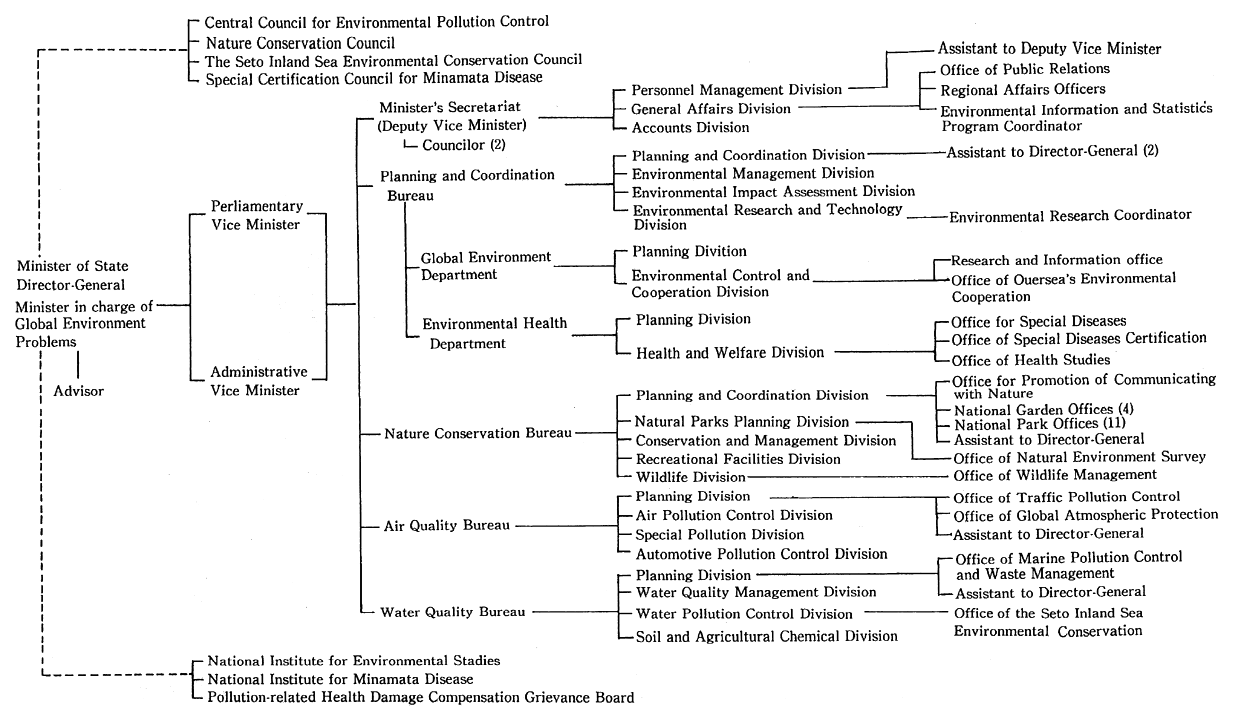
Chart 2. Organization of Central Council for Environmental Pollution Control
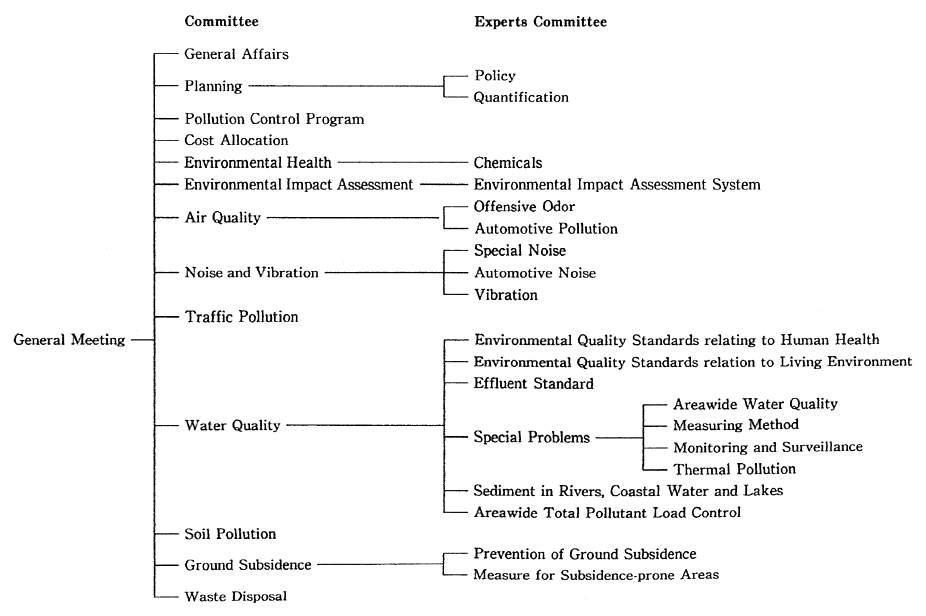
Chart 3. Organization of National Institute for Environmental Studies
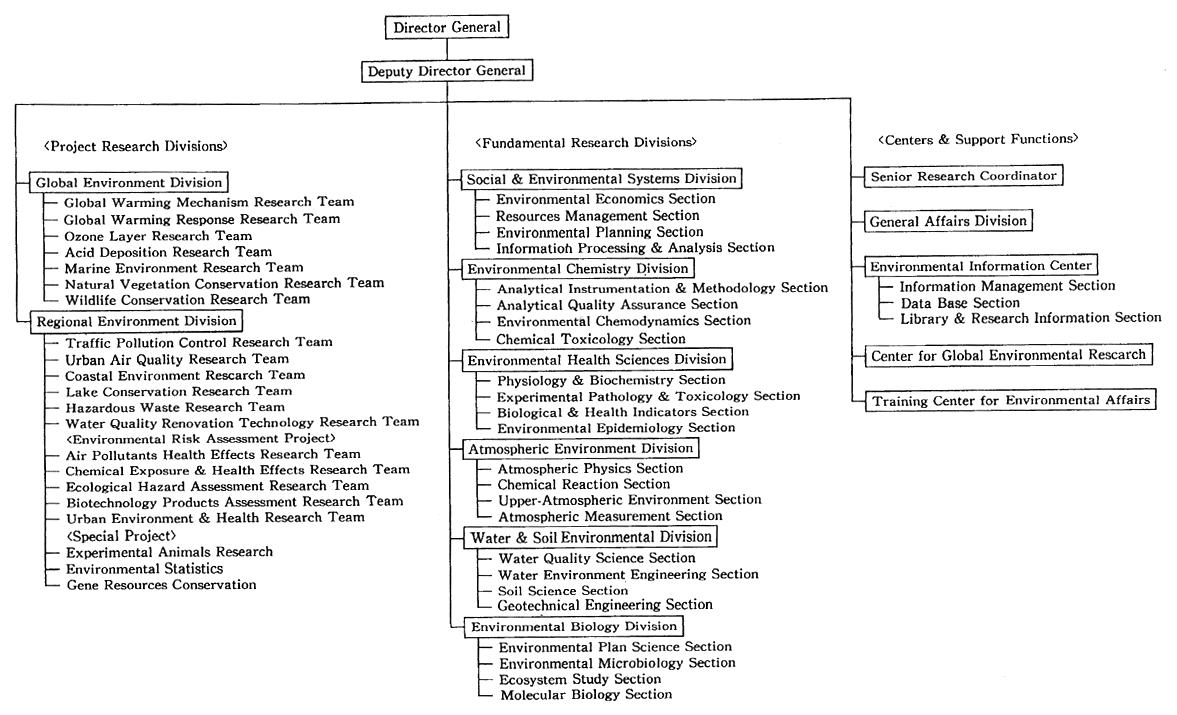
Chart 4. Organization of National Institute for Minamata Disease
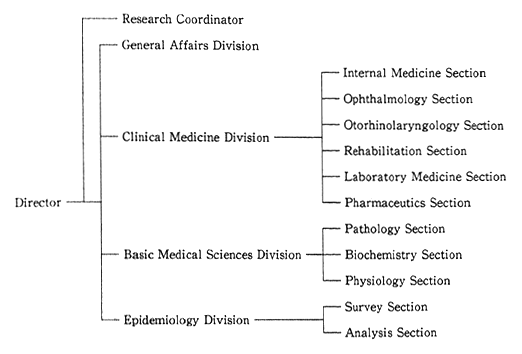
Appendix2. National Standards
1. Ambient Air Quality Standards
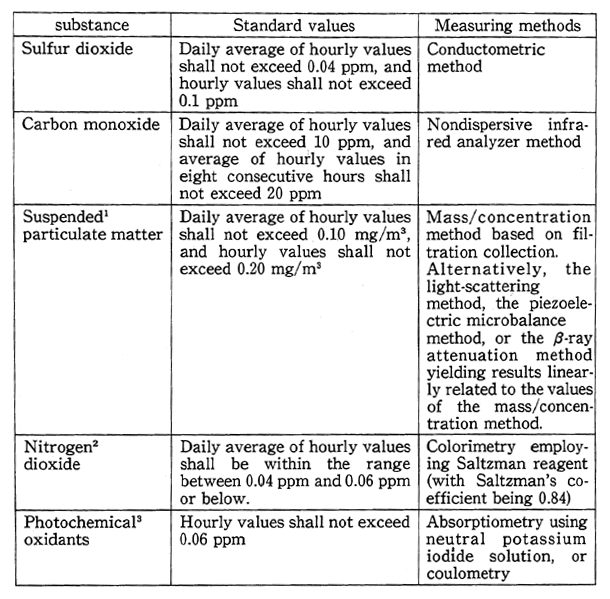
Notes: 1. suspended particulate matter shall mean airborn paritcles of 10 microns or less in diameter.
2. a) In an area where the daily average of hourly values exceeds 0.06 ppm, efforts should be made to achieve the level of 0.06 ppm by 1985.
b) In an area where the daily average of hourly values is within the range between 0.04 ppm and 0.06 ppm, efforts should be made so that the ambient concentration be maintained around the present level within the range or does not significantly exceed the present level.
3. Photochemical oxidants are oxidizing substances such as ozone and peroxiacetyl nitrate produced by photochemical reactions (only those capable of isolating iodine from neutral potassium iodide, excluding nitrogen dioxide).
2. Environmental Quality Standards for Noise
(1) Environmental Quality Standards for Noise (including road side areas)(May 25, 1971)
a. Environmental quality standards
Environmental quality standards values for each type of area and time category shall be as listed in Table 1.
Table 1
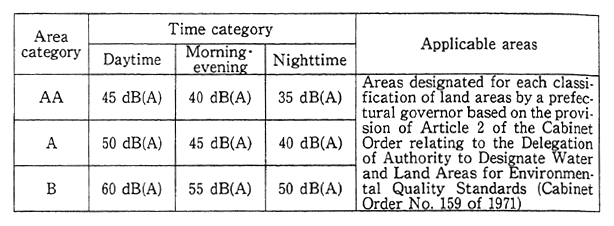
Notes :1. Area coming within category AA are areas where quiet is specially required such as where there is a concentration of convalescent facilities.
2. Areas coming within category A are areas which are used mainly for residential purposes.
3. Areas coming within category B are areas which are used considerably for residential purposes and which are also used for commercial and industrial purposes.
However, with regard to environmental quality standards for the areas of Table 2 (hereinafter referred to as "areas facing roads"), the values hereinbelow shall be applied instead of the values in Table 1.
b. Method of measurement
The method of measurement of noise, units of measurement, and measuring instrument shall be as follows.
(a) The method of measurement shall conform to the noise level measurement method of Japanese Industrial Standard (JIS) Z8731. In principle, mean values shall be employed in evaluating the measurement results.
(b) The unit of measurement shall be dB (A).
(c) The measuring instrument shall be the indicating noise meter prescribed by JIS C1502 or the precision noise meter prescribed by International Electric Standards Conference (IESC) Pub,/179 or equiva-lent instrument.
Table 2
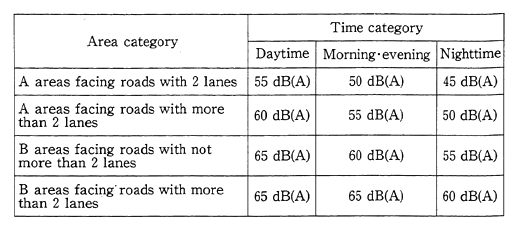
Note:"Lane" refers to a longitudinal strip of road with uniform width requisite to allow a single line of cars to travel therealong safely and without hindrance.